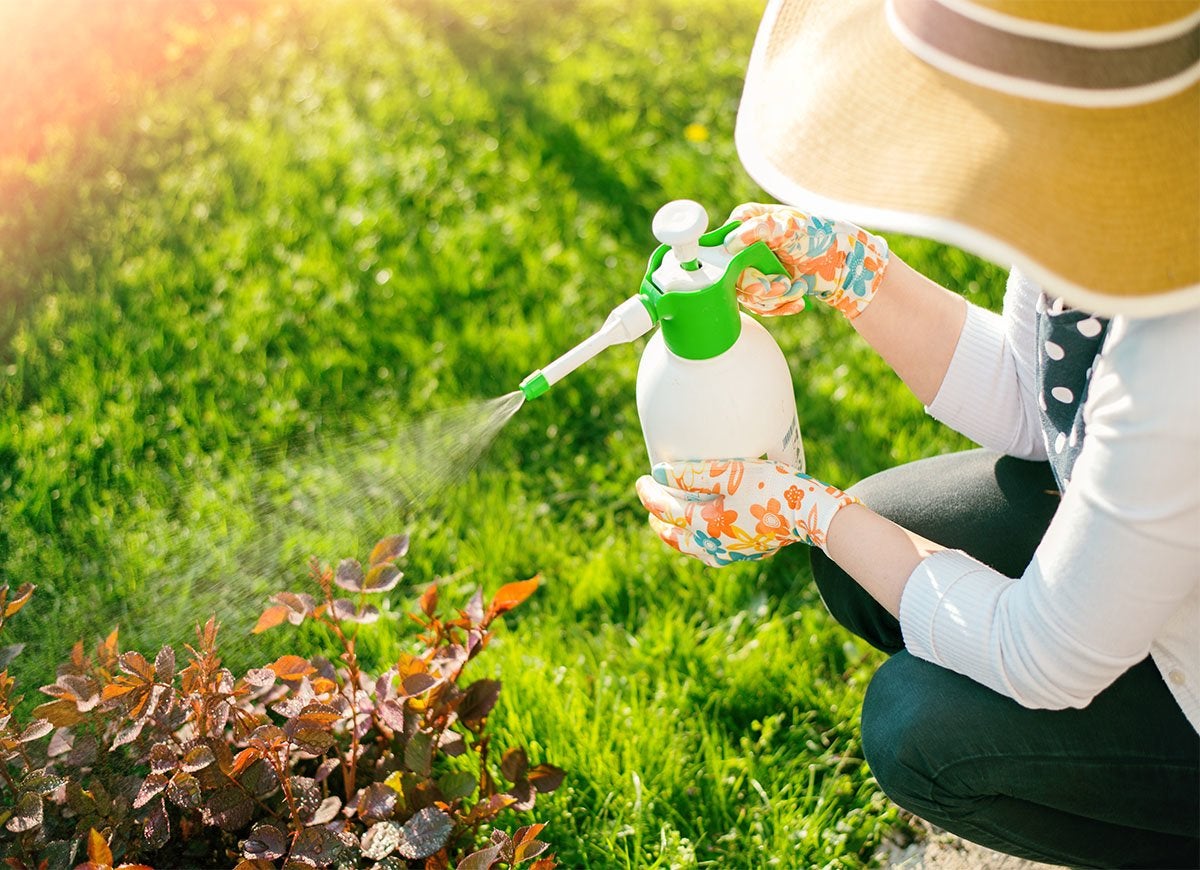Home>Gardening News and Trends>Latest News>How Does Pesticides Affect Humans


Latest News
How Does Pesticides Affect Humans
Modified: January 22, 2024
Discover the latest news on how pesticides affect humans. Stay informed with the most recent research findings and learn about the potential health risks.
(Many of the links in this article redirect to a specific reviewed product. Your purchase of these products through affiliate links helps to generate commission for Chicagolandgardening.com, at no extra cost. Learn more)
Table of Contents
Introduction
Pesticides play a crucial role in modern agriculture by protecting plants from pests and diseases that can cause significant crop damage. However, the use of pesticides has raised concerns about their impact on human health. Pesticides are chemicals specifically designed to kill or control pests, including insects, weeds, fungi, and rodents. While they are effective in their intended purpose, they can have unintended consequences for human beings.
Understanding the potential health effects of pesticides is essential for promoting the well-being of both agricultural workers and consumers. Pesticides can enter the human body through various routes of exposure, including ingestion, inhalation, and dermal contact. Once inside the body, they can accumulate in tissues and organs, potentially leading to acute or chronic health problems.
This article will explore the various routes of pesticide exposure, the health effects they may have on humans, and strategies for minimizing exposure. It is important to note that the impact of pesticides on human health can vary depending on factors such as the type of pesticide, the level of exposure, and individual susceptibility.
By understanding the potential risks associated with pesticide exposure, individuals can make informed choices to protect themselves and their families. It is crucial for regulatory bodies, farmers, and consumers to work together to ensure the safe and sustainable use of pesticides in agriculture.
Let us delve deeper into the topic and explore the impact that pesticides can have on human health.
Understanding Pesticides
Pesticides are chemical substances that are used to control or eliminate pests that can harm crops, livestock, or human health. They are classified into several categories based on the type of pest they target, such as insecticides, herbicides, fungicides, and rodenticides. Each category is designed to effectively combat specific pests, leading to improved agricultural productivity and food security.
These chemicals work by interfering with the physiology or biochemistry of pests, disrupting their ability to reproduce, feed, or grow. While this targeted action is crucial for protecting crops and preventing economic losses, it also raises concerns about the potential impact on non-target organisms, including humans.
Pesticides can be synthetic or naturally derived. Synthetic pesticides are chemically formulated compounds created in laboratories, while naturally derived pesticides come from organic sources, such as plants or minerals. Both types of pesticides have advantages and disadvantages in terms of effectiveness, environmental impact, and potential health risks.
It is important to note that the use of pesticides in agriculture is strictly regulated to ensure their safe and responsible use. Regulatory agencies around the world set limits on pesticide residues in food, establish guidelines for pesticide application, and conduct risk assessments to evaluate the potential impact on human health and the environment.
While pesticides play a vital role in modern agriculture, it is important to consider their potential risks and take necessary precautions to minimize exposure. Understanding the different types of pesticides, their modes of action, and their potential effects on human health is crucial for both farmers and consumers.
In the next section, we will explore the various routes of pesticide exposure and how they can impact human health.
Routes of Exposure
There are several routes through which individuals can be exposed to pesticides. These include:
- Ingestion: The most common route of exposure occurs through the consumption of food and water contaminated with pesticide residues. Pesticides can be absorbed by plants through their root systems or applied directly to crops. It is important to note that even low levels of pesticide residues can accumulate over time.
- Inhalation: Inhalation of pesticides can occur during the mixing, application, or spraying process. Aerosolized pesticides can be inhaled into the lungs, potentially leading to respiratory effects. Long-term exposure to airborne pesticides can also occur near agricultural fields, impacting nearby residents and communities.
- Dermal Contact: Pesticides can be absorbed through the skin when individuals come into direct contact with pesticide-contaminated surfaces or through the handling of pesticide-treated crops or animals. Certain pesticides are formulated to be absorbed through the skin more readily, increasing the risk of dermal exposure.
- Occupational Exposure: Agricultural workers who apply pesticides are at a higher risk of occupational exposure. These individuals may experience direct skin contact, inhalation, and ingestion of pesticides. It is essential for workers to follow safety protocols, wear protective clothing, and use proper equipment to minimize exposure.
The route of exposure can influence the severity and type of health effects experienced. Ingestion and inhalation routes have the potential for systemic effects throughout the body, while dermal exposure may lead to more localized effects.
Understanding the routes of exposure is essential for implementing safety measures, both in agricultural settings and for consumers. In the next section, we will discuss the potential health effects of pesticides on humans.
Health Effects of Pesticides on Humans
Pesticides have the potential to impact human health, depending on factors such as the type of pesticide, level of exposure, and individual susceptibility. The health effects can vary from acute, immediate reactions to chronic, long-term health problems.
Acute Effects: Short-term exposure to high levels of pesticides can lead to acute health effects. These may include headaches, dizziness, nausea, vomiting, skin irritation, eye irritation, respiratory issues, and even more severe symptoms in extreme cases. Acute pesticide poisoning can occur through accidental spills, improper handling, or high levels of exposure in occupational settings.
Chronic Effects: Long-term exposure to low levels of pesticides can have chronic health effects. Research has linked pesticide exposure to an increased risk of certain types of cancers, reproductive disorders, hormonal imbalances, neurodevelopmental disorders, respiratory issues, and immune system dysfunction. The effects can be more pronounced in vulnerable populations, such as children, pregnant women, and individuals with compromised immune systems.
It is important to note that the health effects of pesticides are not limited to agricultural workers. Consumers can also be exposed to pesticide residues through the food they eat. However, it is often difficult to establish a direct cause-and-effect relationship between pesticide exposure and specific health outcomes, as multiple factors can contribute to the development of diseases.
Furthermore, the effects of long-term, low-level exposure to mixtures of pesticides, as experienced by both agricultural workers and consumers, are still being studied. The cumulative and interactive effects of multiple pesticides are complex and not yet fully understood.
While regulatory bodies play a crucial role in setting safety standards and enforcing regulations, individuals can also take steps to minimize their pesticide exposure and potential health risks.
Next, we will discuss the occupational exposure to pesticides and the measures that can be taken to protect workers in agricultural settings.
Acute Effects
Acute effects of pesticide exposure refer to the immediate health consequences that can occur following a high level of exposure. These effects can vary depending on the type of pesticide, the route of exposure, and the individual’s susceptibility. It is important to take precautionary measures to minimize the risk of acute pesticide poisoning.
Common symptoms of acute pesticide poisoning include:
- Headaches and dizziness: Pesticides can affect the central nervous system, leading to headaches and a feeling of dizziness.
- Nausea and vomiting: Ingestion or inhalation of certain pesticides can cause nausea and vomiting.
- Skin and eye irritation: Contact with pesticides, especially those that are dermally toxic, can result in skin rashes, redness, irritation, and eye irritation.
- Respiratory issues: Inhalation of airborne pesticides can irritate the respiratory system, causing coughing, wheezing, and shortness of breath.
In severe cases, acute pesticide poisoning can lead to more serious health complications, such as seizures, loss of consciousness, and even death. Immediate medical attention should be sought if these symptoms occur after exposure to pesticides.
Occupational workers in pesticide-intensive industries, such as agriculture and pest control, are at a higher risk of acute pesticide poisoning due to their frequent and direct exposure to these chemicals. Proper training, education, and adherence to safety protocols, including the use of personal protective equipment, are crucial in preventing acute pesticide poisoning in these settings.
It is also important for individuals who work or live near agricultural fields to be aware of the risks associated with pesticide exposure. Communities situated close to crop spraying operations may be at a heightened risk due to the potential drift of airborne pesticides. Local regulations, buffer zones, and community education programs can help minimize these risks.
In the next section, we will explore the potential long-term health effects of chronic pesticide exposure.
Chronic Effects
Chronic effects of pesticide exposure refer to the long-term health consequences that can occur due to continuous or repeated exposure to low levels of pesticides over an extended period. These effects can manifest over time and are often associated with the cumulative build-up of pesticide residues in the body.
Research has indicated several potential chronic health effects associated with pesticide exposure:
- Cancer: Certain pesticides have been linked to an increased risk of various types of cancer, including leukemia, lymphoma, lung cancer, and prostate cancer. Pesticides with carcinogenic properties can disrupt DNA, affect hormone regulation, and promote the growth of tumors.
- Reproductive disorders: Pesticides, especially those with endocrine-disrupting properties, have been associated with reproductive disorders in both men and women. They can interfere with hormone regulation, leading to fertility issues, birth defects, and complications during pregnancy.
- Neurodevelopmental disorders: Some pesticides have been linked to neurodevelopmental disorders, including autism spectrum disorder, attention deficit hyperactivity disorder (ADHD), and cognitive impairments. The developing brain, especially in children, is more susceptible to the effects of neurotoxic pesticides.
- Respiratory issues: Chronic exposure to certain pesticides, particularly those with respiratory toxicity, can contribute to the development or worsening of respiratory conditions, such as asthma and chronic obstructive pulmonary disease (COPD).
- Immune system dysfunction: Pesticides can disrupt the immune system, making individuals more susceptible to infections, allergies, and autoimmune disorders.
It is important to note that the effects of chronic pesticide exposure can vary depending on factors such as the type of pesticide, the duration of exposure, the timing of exposure (such as during critical periods of development), and individual susceptibility. Certain populations, such as children, pregnant women, the elderly, and individuals with pre-existing health conditions, may be more vulnerable to the effects of chronic pesticide exposure.
While regulatory bodies establish safety standards for pesticide residues in food and enforce restrictions on the use of certain high-risk pesticides, consumers can also take steps to minimize their exposure. Washing produce thoroughly, choosing organic options when available, and maintaining a healthy lifestyle can help reduce pesticide intake.
Next, let’s delve into the issue of occupational exposure to pesticides and the measures that can be taken to protect workers in agricultural settings.
Occupational Exposure
Occupational exposure to pesticides is a significant concern for individuals working in agriculture and pest control industries. These workers often have direct, frequent, and potentially high-level exposure to pesticides, putting them at an increased risk of adverse health effects.
Agricultural workers may be exposed to pesticides through various routes, including dermal contact, inhalation of airborne pesticides, and accidental ingestion. The nature of their work, which involves handling and applying pesticides, increases the likelihood of exposure.
Workers in pest control services, such as exterminators, also face occupational exposure while using pesticides to eliminate pests in residential or commercial settings.
To protect workers from the potential health risks associated with pesticide exposure, several measures should be implemented:
- Training and education: Workers should receive proper training and education on pesticide handling, application, and safety procedures. This includes understanding the potential hazards, proper use of personal protective equipment (PPE), and knowledge of emergency response protocols.
- Use of personal protective equipment (PPE): Workers should use appropriate PPE, such as gloves, coveralls, goggles, respiratory masks, and boots, when working with pesticides. Properly fitted and well-maintained PPE can help minimize the risk of dermal contact, inhalation, and accidental ingestion.
- Safe handling and storage: Pesticides should be stored, transported, and disposed of according to recommended guidelines. Workers should follow proper handling procedures to prevent spills, leaks, or accidents that could lead to exposure.
- Monitoring and surveillance: Regular monitoring and surveillance of workers’ exposure levels can help identify any potential issues and allow for prompt intervention. This can include measures such as air monitoring in work areas and biological monitoring through urine or blood samples.
- Workplace hygiene: Ensuring proper hygiene practices, such as handwashing facilities and designated areas for eating and drinking away from pesticide storage or application areas, can help minimize inadvertent exposure.
Regulatory bodies play a vital role in enforcing safety standards and regulations to protect workers from occupational pesticide exposure. Employers should comply with these regulations and provide a safe working environment.
By implementing these measures, the risks associated with occupational exposure to pesticides can be mitigated, safeguarding the health and well-being of workers in the agricultural and pest control sectors.
In the next section, we will discuss the vulnerability of certain populations to pesticide exposure.
Vulnerable Populations
Some populations are more susceptible to the potential health risks associated with pesticide exposure. Certain individuals, due to their age, health status, or developmental stage, are considered more vulnerable to the adverse effects of pesticides.
Children: Children have unique vulnerabilities to pesticide exposure. Their bodies are still developing, and their organs may be more sensitive to the toxic effects of pesticides. Exposure to pesticides during critical stages of development can have long-lasting effects on their cognitive and physical health. Children also have higher exposure potentials due to their behaviors, such as crawling on the floor or putting objects in their mouths.
Pregnant Women: Pregnant women are at risk of passing pesticide residues to their developing fetus. Pesticide exposure during pregnancy has been associated with adverse birth outcomes, including preterm birth, low birth weight, and developmental disabilities. It is essential for pregnant women to minimize exposure to pesticides, especially during early pregnancy when crucial organ development occurs.
Elderly: Older individuals may have weakened immune systems, decreased liver function, and reduced renal clearance, making them more susceptible to the toxic effects of pesticides. They may also have pre-existing health conditions that can be exacerbated by pesticide exposure.
Individuals with Pre-existing Health Conditions: Those with respiratory conditions, weakened immune systems, allergies, or compromised liver or kidney function may be more sensitive to the effects of pesticides. Pesticide exposure can exacerbate their symptoms or lead to further health complications.
Vulnerable populations require special attention and protective measures to minimize their risk of pesticide exposure. Strategies include:
- Reducing exposure: Implementing practices that minimize pesticide exposure for vulnerable populations, such as using alternative pest management methods or adopting organic farming practices.
- Education and awareness: Providing education and raising awareness among vulnerable populations and their caregivers about the potential risks of pesticide exposure, as well as ways to minimize exposure in their daily lives.
- Regulatory measures: Strengthening regulations and safety standards to protect vulnerable populations, including setting stricter limits for pesticide residues in food and enhancing workplace safety protocols in agricultural and pest control settings.
- Supporting research: Further research is needed to better understand the specific risks and impacts of pesticides on vulnerable populations, enabling the development of targeted interventions and protective strategies.
By focusing on the needs of vulnerable populations, we can work towards creating a safer environment and reducing the potential health risks associated with pesticide exposure.
In the next section, we will explore the presence of pesticide residues in food and the measures in place to regulate and ensure their safety.
Pesticide Residues in Food
Pesticide residues in food are a concern for consumers because they represent a potential source of exposure to these chemicals. Pesticide residues can remain on food crops even after they have been harvested, processed, and prepared for consumption.
Regulatory bodies around the world have established guidelines and safety standards to regulate the levels of pesticide residues in food. These limits are set based on extensive scientific research and risk assessments to ensure that the levels of pesticides in food are below the levels considered harmful to human health.
Monitoring and testing programs are implemented to assess and verify compliance with these safety standards. These programs involve sampling and analyzing a wide range of food products to ensure that pesticide residue levels are within acceptable limits.
Consumers can also take steps to minimize their exposure to pesticide residues in food:
- Wash and peel fruits and vegetables: Thoroughly washing fresh produce under running water can help remove surface pesticide residues. Peeling fruits and vegetables can further reduce exposure, but it is important to note that some nutrients may be lost along with the peel.
- Choose organic options: Organic farming practices prohibit the use of synthetic pesticides, so choosing organic produce can help reduce exposure to pesticide residues. However, it is important to remember that organic does not necessarily mean pesticide-free, as certain organic-approved pesticides may still be used.
- Diversify your diet: Eating a variety of fruits, vegetables, and other food items can help reduce exposure to any single pesticide. By consuming a diverse range of foods, the overall pesticide intake is spread out.
- Follow food safety guidelines: Properly storing and handling food, along with cooking it at appropriate temperatures, can also help reduce the potential risk of pesticide exposure.
It is essential to note that the presence of pesticide residues in food does not necessarily mean immediate harm. The safety standards set by regulatory bodies are designed to ensure that the levels of pesticide residues in food do not pose significant risks to human health, even with long-term exposure.
However, ongoing research and continuous monitoring are essential to ensure the effectiveness of these safety measures and to identify any emerging risks associated with new pesticide formulations or changes in pesticide usage patterns.
In the next section, we will discuss the regulations and safety measures in place to control and minimize pesticide exposure.
Regulation and Safety Measures
Regulation and safety measures play a crucial role in minimizing and controlling pesticide exposure, both in agricultural settings and for consumers. Governments and regulatory bodies around the world have implemented strict guidelines and regulations to ensure the safe use of pesticides and protect human health and the environment.
Some key aspects of pesticide regulation and safety measures include:
- Pesticide Registration: Before a pesticide can be sold and used, it must go through a rigorous evaluation process. Regulatory bodies assess its efficacy, potential health and environmental risks, and appropriate application methods. Pesticides that pass these evaluations are registered and assigned specific recommendations for their safe and effective use.
- Setting Safety Standards: Regulatory bodies establish safety standards that include maximum residue limits (MRLs) for pesticide residues in food, as well as maximum permissible levels in water, soil, and air. These safety standards are based on extensive scientific research and aim to ensure that exposure to pesticides remains below levels considered harmful to human health.
- Monitoring and Enforcement: Regular monitoring programs are in place to assess the presence of pesticide residues in food. Samples are collected and analyzed to ensure that the levels of pesticide residues comply with the established safety standards. Regulatory bodies also enforce regulations and conduct inspections to ensure compliance with safety guidelines in agricultural and pest control settings.
- Safe Use and Handling: Guidelines and best practices are developed to promote the safe and responsible use of pesticides. These include recommendations for proper storage, transportation, application, and disposal of pesticides. Training programs for pesticide applicators and agricultural workers focus on safety protocols, PPE usage, and good agricultural practices.
- Integrated Pest Management (IPM): IPM approaches are promoted to minimize reliance on pesticides and maximize the efficacy of pest management strategies. IPM combines various pest control methods, such as biological control, crop rotation, and cultural practices, to reduce pesticide use while maintaining effective pest control.
Regulatory bodies continuously review and update regulations and safety measures based on ongoing research and emerging scientific evidence. The goal is to improve the effectiveness of safety measures, minimize pesticide exposure, and adapt to changing pesticide formulations and technological advancements.
Public awareness and education about pesticide safety are also important components of regulation and safety measures. Providing clear information to farmers, workers, and consumers about the risks associated with pesticide exposure and promoting best practices for minimizing exposure can help protect human health and the environment.
In the next section, we will discuss strategies for minimizing pesticide exposure in everyday life.
Minimizing Pesticide Exposure
Minimizing pesticide exposure is important to protect human health and reduce potential risks associated with these chemicals. While regulatory bodies set safety standards and enforce regulations, individuals can also take steps to minimize their exposure to pesticides in everyday life.
Here are some strategies for minimizing pesticide exposure:
- Choose Organic: Opt for organic produce whenever possible. Organic farming practices avoid the use of synthetic pesticides, reducing pesticide residues in food.
- Wash Fruits and Vegetables: Thoroughly wash fruits and vegetables under running water to remove pesticide residues. This can help reduce exposure, even if the produce is not organic.
- Peel and Trim: Consider peeling the skin of fruits and vegetables, as pesticide residues tend to accumulate on the surface. Trimming fat from meat and poultry can also reduce exposure to fat-soluble pesticide residues.
- Buy Locally: Purchase food from local farmers’ markets or participate in community-supported agriculture (CSA) programs. Locally produced food often has lower pesticide use due to smaller-scale farming practices.
- Be Informed: Stay informed about pesticides used on different crops to make better choices. The Environmental Working Group (EWG) publishes a yearly list called the “Dirty Dozen” that highlights the fruits and vegetables with the highest pesticide residues, and the “Clean Fifteen” showcasing those with the least.
- Follow Integrated Pest Management (IPM) Practices: Encourage farmers to adopt IPM practices that focus on minimizing pesticide use and integrating other pest control methods.
- Reduce Home Use: Limit the use of pesticides in and around your home by exploring natural alternatives and adopting preventive measures, such as removing pest habitats and sealing entry points.
- Read Labels: Follow the instructions on pesticide labels carefully when using them for personal purposes. Use them as directed and adhere to recommended safety precautions.
It is crucial to note that eliminating all pesticide exposure is nearly impossible in today’s world. However, by implementing these strategies and making informed choices, individuals can significantly reduce their pesticide exposure and associated risks.
Ultimately, a collective effort involving individuals, farmers, regulatory bodies, and agricultural practices is needed to promote safer and sustainable approaches to pest management.
To conclude, minimizing pesticide exposure is crucial for protecting human health and the environment. By being aware and proactive, we can reduce our exposure to pesticides and contribute to a healthier and more sustainable future.
Conclusion
Pesticides play a vital role in modern agriculture by protecting crops from pests and diseases. However, their use raises concerns regarding their impact on human health. Understanding the potential health effects of pesticides is crucial for both agricultural workers and consumers.
Pesticides can enter the human body through ingestion, inhalation, or dermal contact. They can have acute effects, resulting in immediate symptoms such as headaches, nausea, and skin irritation. Long-term exposure to low levels of pesticides can lead to chronic effects, including an increased risk of cancer, reproductive disorders, neurodevelopmental disorders, and respiratory issues.
Occupational workers in agriculture and pest control industries are at a higher risk of pesticide exposure. Proper training, the use of personal protective equipment, and adherence to safety protocols can help minimize their exposure.
Vulnerable populations, such as children, pregnant women, the elderly, and individuals with pre-existing health conditions, require special attention due to their increased susceptibility to the adverse effects of pesticides. Additional protective measures and targeted interventions are needed for these groups.
Regulatory bodies play a crucial role in setting safety standards, conducting monitoring programs, and enforcing regulations to protect human health. Individuals can also take steps to minimize pesticide exposure, such as choosing organic produce, washing fruits and vegetables, and following integrated pest management practices.
Minimizing pesticide exposure is a collective effort that requires collaboration between farmers, regulatory bodies, and consumers. By promoting safer and sustainable farming practices, supporting ongoing research, and raising awareness about pesticide safety, we can work towards reducing the potential risks associated with pesticide exposure.
Ultimately, the goal is to strike a balance between the benefits of pesticides in protecting crops and the need to safeguard human health and the environment. By prioritizing safety measures and promoting responsible pesticide use, we can pave the way towards a healthier and more sustainable future.






